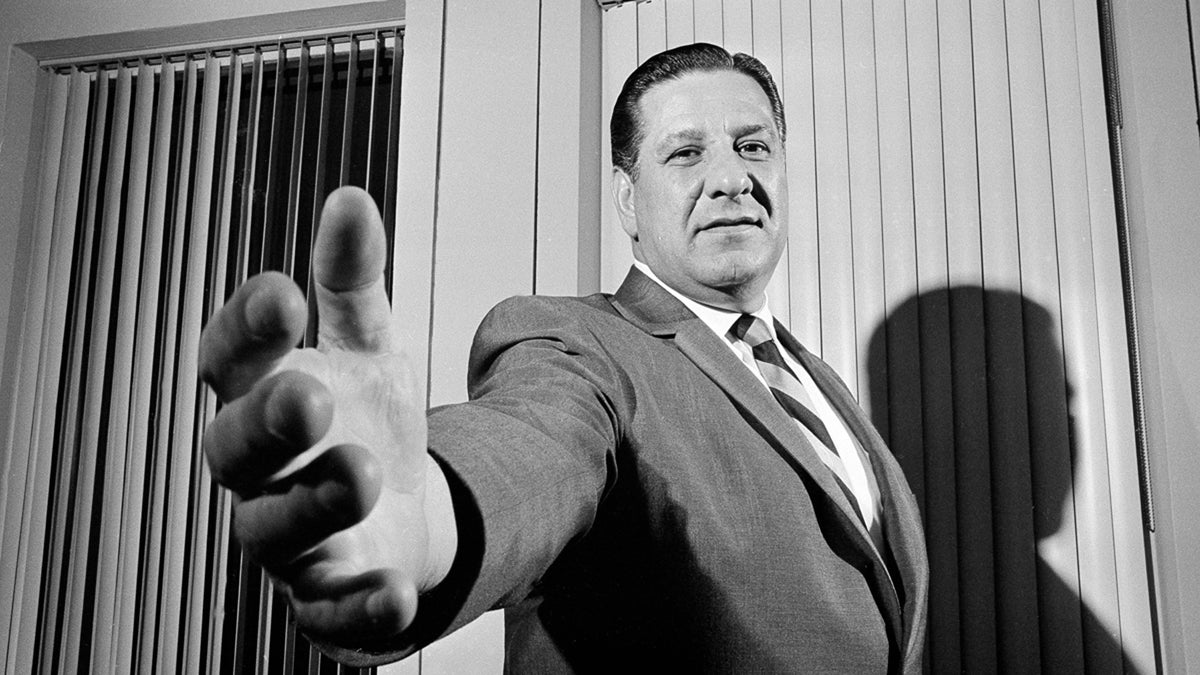Rizzo-era leaders weigh in on the statue debate
Listen
In 1968, Philadelphia Police Commissioner Frank Rizzo, then 47. extends a hand at his office in police headquarter. (Bill Achatz/AP Photo)
Nearly three decades after his death, Frank Rizzo is again roiling Philadelphia politics and public opinion.
Demands to remove his statue from the plaza of the city’s Municipal Services Building have prompted Mayor Jim Kenney to invite public comment and consider initiating the process for moving the monument.
Who’s offended by the statue?
It struck me that most of the people demanding its removal are too young to remember Rizzo as mayor.
Anybody younger than 37 wasn’t even born when he last held public office.
I wondered how politicians and activists who battled with Rizzo in the ’60s and ’70s feel about this.
Rizzo was a polarizing figure as mayor and police commissioner, but he lived 11 years after he left City Hall as a very public figure. He had a daily radio talk show. He ran for mayor three times, and clearly toned down his act.
I wondered if his old adversaries still spit when Rizzo’s name is mentioned — or if their views of him had mellowed with time.
Memories that don’t die
I called former Mayors W. Wilson Goode and Ed Rendell; Shelly Yanoff, who directed the “Recall Rizzo” campaign; Kevin Vaughan, an African-American gay man who led the city’s Human Relations Commission; and others.
It’s fair to say they haven’t gone soft on Frank Rizzo.
Talking with these veterans of the ’70s reminded me of some jaw-dropping moments that are easy to forget. Apart from the accusations of racially directed police brutality, there were serious indications of Rizzo’s willingness to abuse his power as mayor.
There were credible allegations that police officers were assigned to trail Rizzo’s political opponents to find dirt or intimidate them. Former Mayor Richardson Dilworth made that charge to reporter Joe Daughen, reported in Daughen’s book with Peter Binzen, “The Cop Who Would Be King.”
And there was the day in 1976 that Rizzo’s allies in the building trades sent more than 200 men to surround the Philadelphia Inquirer building, preventing people from entering and newspaper delivery trucks from leaving for hours, while the police did nothing. That happened after it was learned that a harsh, satirical piece about Rizzo was coming in the Sunday paper.
Yanoff said Rizzo created a climate of fear when she was directing the movement to recall Rizzo, collecting signatures to remove him from office.
“I had a young girl, about 8 at the time, my youngest,” Yanoff told me. “And I got calls saying, ‘I see your daughter on her way to school. You better watch what you’re saying.'”
Yanoff doesn’t believe Rizzo ordered any threats, but that he created an atmosphere that encouraged it.
How did this happen?
It’s striking that given the strong feelings about Rizzo, there was so little public opposition later when his supporters raised money for a statue and proposed installing it in a prominent civic space.
Looking at press accounts of meetings of the Philadelphia Art Commission and Fairmount Park Commission, I saw debate about what location might best suit the statue. But I didn’t see anyone saying that Rizzo was a blight on the city’s history and undeserving of the honor.
Why was there no real opposition?
The issue arose in 1994, and public views were probably softened by Rizzo’s long time out of office, as well as the praise and tributes he got when he died suddenly in 1991.
And there was the fact the city had nearly gone broke in 1990, and the civic agenda was about fiscal stability and reviving the city’s image.
I asked then-Mayor Rendell about the discussion on the site of the statue.
“You know, they asked me could it be placed at the Municipal Services Building, and I basically said, ‘Why not?’ You know, he was mayor, and why not?” Rendell said.
Rendell now says it may not have been the right place for the statue, and if the art commission wants to move it, it should carefully consider what would be a better place.
Goode won’t take a position on moving the statue because he has a policy as a former mayor of not commenting on decisions facing those in the mayor’s office.
A common refrain from former adversaries of Rizzo came from Vaughan, who served as director of the city’s Human Relations Commission.
He has nothing good to say about Rizzo, but he can’t get enthused about a crusade to move the statue.
“There are many, many things that we can do in Philadelphia together to make Philadelphia a better place,” Vaughan said. “Whether Frank Rizzo is standing in front of the Municipal Services Building forever or not is not one of those issues.”
The city’s Office of Arts, Culture and the Creative Economy is soliciting views from the public on the statue’s future until Sept. 15.
After that, the city will decide whether to initiate the process for removing the statue, which would involve public hearings and a vote of the Philadelphia Art Commission.
WHYY is your source for fact-based, in-depth journalism and information. As a nonprofit organization, we rely on financial support from readers like you. Please give today.


